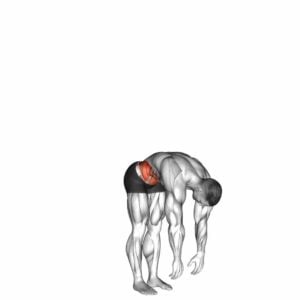Spine (Lumbar) – Extension – Video Exercise Guide & Tips

Looking to strengthen your lumbar spine? This video exercise guide is here to help.
Watch This Exercise Video
With easy-to-follow tips and proper form techniques, you'll learn how to properly extend your spine for maximum benefits.
From relieving back pain to improving flexibility, this guide has it all.
Grab your equipment and get ready to take your spine health to the next level.
Let's dive in and start improving your lumbar extension today!
Key Takeaways
- Lumbar spine extension exercises can improve posture and reduce slouching.
- Gradually increasing the intensity and range of motion can strengthen the erector spinae muscles and increase flexibility in the lower back.
- Maintaining proper form, engaging the core, and avoiding excessive arching are important precautions to prevent injury.
- Consultation with a healthcare professional is recommended if experiencing pain or discomfort during lumbar spine extension exercises.
Benefits of Lumbar Spine Extension
What are the benefits of performing lumbar spine extension exercises?
Lumbar spine extension exercises offer several benefits, including improved posture and increased flexibility. These exercises target the muscles in the lower back, known as the erector spinae muscles, which play a crucial role in maintaining proper alignment of the spine. By strengthening these muscles, you can achieve better posture, as they help support the natural curve of the spine and prevent slouching.
In addition to improved posture, lumbar spine extension exercises also promote increased flexibility in the lower back. These exercises involve extending the spine backward, which helps to stretch and lengthen the muscles and connective tissues in the lumbar region. This increased flexibility can improve range of motion and reduce stiffness in the lower back, making daily movements and activities easier and more comfortable.
Regularly performing lumbar spine extension exercises can have a positive impact on your overall spinal health. They not only strengthen the muscles that support the spine but also increase flexibility, leading to improved posture and reduced discomfort. Incorporating these exercises into your fitness routine can help you maintain a healthy and functional spine.
Precautions and Safety Tips
To ensure your safety and minimize the risk of injury, it's important to follow these precautions and safety tips when performing lumbar spine extension exercises:
- Start Slowly: When beginning lumbar spine extension exercises, it's crucial to start slowly and gradually increase the intensity and duration of the exercise. This allows your body to adapt and prevents sudden strain on your spine.
- Maintain Proper Form: Maintaining proper form is essential for injury prevention during lumbar spine extension exercises. Keep your core engaged, your hips aligned, and avoid excessive arching of the back. Remember to focus on the movement coming from your lower back rather than using momentum.
- Avoid Common Mistakes: There are a few common mistakes to avoid when performing lumbar spine extension exercises. Avoid jerky movements and excessive twisting, as these can put unnecessary strain on your back. Additionally, be mindful of overextending your spine, as this can lead to hyperextension and potential injury.
By following these precautions and safety tips, you can reduce the risk of injury and ensure a safe and effective lumbar spine extension exercise routine.
Remember to listen to your body and consult with a healthcare professional if you experience any pain or discomfort.
Equipment Needed for the Exercises
To perform lumbar spine extension exercises safely and effectively, you'll need certain equipment. The good news is that you don't need any fancy or expensive equipment for these exercises. In fact, you can do most of them right at home with just a few basic items.
First and foremost, you'll need a sturdy and comfortable exercise mat or a padded surface to lie on. This will provide support and cushioning for your body during the exercises.
Additionally, you may want to have a small towel or cushion handy to place under your lower back for added support.
Another useful piece of equipment is an exercise ball or stability ball. This versatile tool can be used for a variety of exercises that target the lower back muscles.
Lastly, a resistance band or a set of dumbbells can be used to add extra resistance and intensity to your lumbar spine extension exercises.
With these equipment items, you'll be well-equipped to perform the exercises safely and effectively.
Now, let's move on to the next section where we'll explore a video exercise guide for lumbar spine extension.
Video Exercise Guide for Lumbar Spine Extension
To get started with the Video Exercise Guide for Lumbar Spine Extension, equip yourself with the necessary equipment mentioned earlier.
Now, let's dive into the exercises that will help improve your lumbar spine flexibility and strengthen your lower back.
- Lumbar Spine Extension: Begin by lying on your stomach with your hands under your shoulders. Slowly push your upper body off the ground, keeping your hips and legs relaxed. Hold this position for a few seconds, then lower back down. Repeat for 10-15 repetitions.
- Superman Exercise: Lie on your stomach with your arms extended in front of you. Lift your arms, chest, and legs off the ground simultaneously, creating a 'superman' pose. Hold for a few seconds, then lower back down. Repeat for 10-15 repetitions.
- Bridge Exercise: Lie on your back with your knees bent and feet flat on the ground. Lift your hips off the ground, creating a straight line from your knees to your shoulders. Hold for a few seconds, then lower back down. Repeat for 10-15 repetitions.
Performing these lumbar spine extension exercises regularly can help improve flexibility and strengthen your lower back muscles. Remember to listen to your body and stop if you experience any pain or discomfort.
Tips for Proper Form and Technique
Now that you have learned the exercises for lumbar spine extension, let's delve into some tips to ensure proper form and technique.
Proper alignment is crucial when performing these exercises to avoid strain or injury. To maintain proper alignment, start by lying flat on your stomach with your legs extended and your hands by your shoulders. Keep your pelvis in a neutral position and engage your core muscles to support your spine.
As you lift your upper body off the ground, focus on extending your spine without overarching or hunching your back. Avoid lifting your shoulders too high or shrugging them towards your ears. Instead, aim to lengthen your spine and keep your neck in line with your spine throughout the movement.
Common mistakes to avoid include using momentum to lift your body instead of relying on your back muscles, which can lead to strain or injury. Additionally, be mindful of not holding your breath during the exercise. Remember to breathe steadily and exhale as you lift your upper body off the ground.
Lastly, avoid jerky or sudden movements and instead, focus on controlled and smooth motions throughout the exercise. By following these tips and maintaining proper form and technique, you can effectively strengthen your lumbar spine while minimizing the risk of injury.
Frequently Asked Questions
Can Lumbar Spine Extension Exercises Help With Sciatica Pain?
Lumbar spine extension exercises can be beneficial for relieving sciatica pain. By engaging the muscles in your lower back, these exercises help to stretch and strengthen the spine, promoting proper alignment and reducing pressure on the sciatic nerve.
Some of the best lumbar spine extension exercises include prone press-ups, cat-camel stretches, and the sphinx pose. Incorporating these exercises into your routine can provide relief and improve your overall spinal health.
How Often Should I Perform Lumbar Spine Extension Exercises?
To reap the benefits of regular lumbar spine extension exercises, it's important to consider the frequency at which you perform them. How often you should do these exercises depends on your individual needs and goals.
However, it's generally recommended to incorporate them into your workout routine at least 2-3 times a week. Consistency is key to strengthening your lower back, improving flexibility, and reducing the risk of future injuries.
Are There Any Alternative Exercises for Lumbar Spine Extension?
Looking for alternative exercises for lumbar spine extension?
There are a few options you can try. These exercises provide similar benefits as lumbar spine extension, such as improving posture, strengthening the lower back, and reducing back pain.
Some alternatives include:
- Superman exercises
- Bird dog exercises
- Prone press-ups
Incorporating these exercises into your routine can help you diversify your workouts and target different muscles in your lower back.
Can Lumbar Spine Extension Exercises Improve Posture?
Lumbar spine extension exercises have numerous benefits, including improving posture. By engaging the muscles in the lower back, these exercises can help strengthen and lengthen the spine, promoting better alignment.
Techniques such as prone press-ups and back extensions can be effective in targeting the lumbar region and improving posture. Incorporating these exercises into your routine can contribute to a more balanced and upright posture, reducing the risk of back pain and enhancing overall body alignment.
Are There Any Specific Stretches or Warm-Up Exercises Recommended Before Performing Lumbar Spine Extension Exercises?
Before performing lumbar spine extension exercises, it's recommended to incorporate preparatory stretches and a warm-up routine. This helps to prepare your body for the movements and reduces the risk of injury.
Preparatory stretches focus on loosening up the muscles in the lower back and surrounding areas, while a warm-up routine increases blood flow and improves overall flexibility.
These exercises are essential in ensuring a safe and effective lumbar spine extension workout.
Conclusion
In conclusion, lumbar spine extension exercises can provide numerous benefits, such as improved flexibility, reduced back pain, and enhanced posture.
However, it's crucial to follow precautions and ensure safety while performing these exercises. Using the appropriate equipment and maintaining proper form and technique are essential for maximizing the effectiveness of these exercises.
By incorporating lumbar spine extension exercises into your routine, you can promote a healthy and strong spine.

Author
Years ago, the spark of my life’s passion ignited in my mind the moment I stepped into the local gym for the first time. The inaugural bead of perspiration, the initial endeavor, the very first surge of endorphins, and a sense of pride that washed over me post-workout marked the beginning of my deep-seated interest in strength sports, fitness, and sports nutrition. This very curiosity blossomed rapidly into a profound fascination, propelling me to earn a Master’s degree in Physical Education from the Academy of Physical Education in Krakow, followed by a Sports Manager diploma from the Jagiellonian University. My journey of growth led me to gain more specialized qualifications, such as being a certified personal trainer with a focus on sports dietetics, a lifeguard, and an instructor for wellness and corrective gymnastics. Theoretical knowledge paired seamlessly with practical experience, reinforcing my belief that the transformation of individuals under my guidance was also a reflection of my personal growth. This belief holds true even today. Each day, I strive to push the boundaries and explore new realms. These realms gently elevate me to greater heights. The unique combination of passion for my field and the continuous quest for growth fuels my drive to break new ground.







